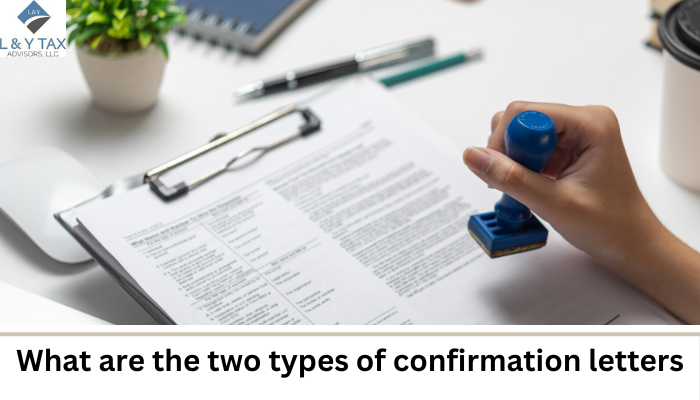
What are the Two Types of Confirmation Letters?
Confirmation letters are essential for authenticating an organization’s financial facts. Learning what are the two types of confirmation letters will help your firm prepare beforehand for any upcoming consequences.
Auditors use confirmation letters to ask third parties, such as banks, suppliers, and other business partners, for independent verification. This makes it easier for them to verify the transparency and reliability of the financial accounts they are reviewing.
L&Y Tax Advisors helps you learn what are the two types of confirmation letters and their roles in the audit procedure.
Audit Confirmation Letter
Auditors use confirmation letters to verify several financial elements of your corporation. For instance, to validate the accuracy of the reported balance, the auditor writes a confirmation document to a vendor whose amount is shown in the organization’s accounts receivable ledger.
This procedure is also used for:
- Contracts
- Cash balances
- Inventory counts
- Notes payable
- Legal issues
Audit integrity depends on the auditors gathering independent, trustworthy evidence through third-party validation.
What are the Two Types of Confirmation Letters in Audit?
In a company’s audit, the fundamental types of confirmation documents are:
- Positive confirmation letter
- Negative confirmation letter
Both perform distinct functions during the auditing process.
Positive Confirmation Letter
The auditor requests a direct answer from a third party verifying the correctness of the information supplied in a positive confirmation letter. The third party is asked to clarify whether they concur or disagree with the information provided in the letter.
This kind of confirmation letter is useful when the auditor needs to be highly certain about a specific item on the financial statement.
For instance, a positive confirmation letter asks the bank to confirm the amount directly. It might be issued if an auditor needs to verify a significant cash balance maintained by the bank.
Negative Confirmation Letter
A negative confirmation letter asks for a response if the third party disputes the information supplied. This method is frequently employed when the auditor determines that there is little chance of a significant misrepresentation and that the information will probably not be contested by a third party.
For instance, negative confirmation letters can be used if an auditor issues several confirmations for lesser account balances since they expedite the procedure and lessen the load on the other parties.
The Importance of Confirmation Letters
For auditors, confirmation letters are essential because they offer an unbiased examination of the financial information that the company presents.
Auditors are assisted in determining the accuracy and completeness of the financial accounts by the comments they get, regardless of whether they validate or refute the information.
In the event that inconsistencies emerge or a third party does not reply, the auditors must take extra steps to clear up any doubts.
Read about the IRS & state audit representation.
What is a Legal Confirmation Letter?
In the legal or financial sector, a legal confirmation letter is a tangible, formal communication documented to establish or verify a particular:
- Fact
- Obligation
- Agreement
In audit settings, an auditor sends this kind of letter to a third party, such as a:
- Bank
- Supplier
- Creditor
Through this letter, the auditor is requesting independent verification of the information the audited company has reported. Auditors use such letters to confirm items like:
- Cash balances
- Obligations
- Legal issues
Besides auditing, legal confirmation letters are used in:
- Transactional law
- Contract verification
- Affirmation of disputable commitments
Can a Confirmation Letter be Used as Proof?
Yes – subject to its credibility and context – a confirmation letter can serve as documentary evidence or proof in several proceedings, like:
- Legal
- Financial
- Audit
When a third party directly affirms the accuracy of information, a confirmation letter provides independent, external support for assertions made by the audited entity.
In auditing, such confirmations strengthen the credibility of monetary statements. However, like any evidence, its probative value depends on authenticity:
- Whether the confirmer is impartial, or
- Whether cross‐verifiable supporting documentation exists.
The Bottom Line
Gaining information on how auditors gather and assess external evidence during an audit requires understanding what are the two types of confirmation letters. Through these instruments, auditors can improve the reliability of their conclusions and add to the general openness and credibility of financial reporting.
Read More:
list three things you should look for when hiring a tax professional


